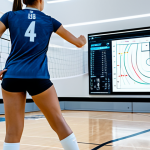There’s something uniquely satisfying about watching a live volleyball match, isn’t there? Just last night, I was completely absorbed by the intensity of the VNL finals, witnessing some truly unbelievable spikes and heart-pounding rallies.
The sheer raw energy I felt, the collective gasps from the crowd with every block, it was electric – a feeling that just begs to be shared and dissected with fellow fans.
It’s not just about the final score; it’s about those pivotal moments, the strategic plays, and the individual brilliance that makes you want to hit pause and rewind.
What really struck me, beyond the immediate thrill, was how quickly the conversation shifted online. Moments after the final point, my social feeds were buzzing with instant replays, advanced analytics, and passionate debates over referee calls – a far cry from the post-game chatter around a water cooler just a decade ago.
We’re in an era where data-driven insights are transforming how we understand and appreciate the game, influencing everything from coaching strategies to fan engagement platforms.
This rapid exchange of expert opinions and fan theories, often fueled by predictive models or deep statistical dives, shapes our collective understanding of player performance and team dynamics.
Whether it’s dissecting an outside hitter’s approach or analyzing a libero’s defensive coverage, the desire to truly understand ‘what happened’ and ‘why’ is stronger than ever.
It’s this evolving landscape of sports discussion that fascinates me. We’re moving towards a future where AI might even predict player fatigue or optimize rotations in real-time, making post-game analysis even richer and more nuanced.
Getting together to dissect a match isn’t just a casual chat anymore; it’s an opportunity to pool insights, challenge perceptions, and truly appreciate the layers of complexity in modern volleyball.
And honestly, sharing those moments of utter disbelief or pure joy with someone who felt the exact same way just amplifies the whole experience. Let’s dive deeper into the article below.
Decoding the Dynamics: The Instant Replay Revolution

There’s an undeniable thrill that comes with watching a live volleyball match unfold, but honestly, the real magic for me often begins when the whistle blows for the final time. That’s when the post-game analysis truly kicks off, amplified exponentially by the power of instant replay. I remember watching a crucial rally just last week where an outside hitter seemed to pull off an impossible cross-court spike. In real-time, it was a blur of power and precision. But then, hitting rewind on my streaming service, I could dissect every micro-movement: the approach, the contact point, the angle of the wrist, even the subtle shift in the blocker’s posture. It’s these granular details, often missed in the heat of the moment, that truly reveal the genius of the play. We’re not just passive observers anymore; we’re empowered detectives, armed with the tools to rewind, pause, and zoom, revealing layers of complexity that were once the exclusive domain of professional analysts. This immediate access to multiple angles and slow-motion replays transforms our understanding from mere appreciation to genuine, informed analysis, making every discussion infinitely richer.
1.1 The Unseen Angles: What Broadcasts Miss
When you’re watching a live broadcast, even with the best directors, you’re always seeing what someone else wants you to see. They focus on the ball, the big hits, the celebrations. But what about the setter’s footwork on a quick transition play, or the slight hesitation in a middle blocker’s jump that opened up a seam? My own experience, especially when analyzing games for my fantasy league, has taught me that these “unseen angles” are where the true insights lie. I often find myself searching for fan-recorded clips or alternative streams that offer a wider court view, allowing me to track player movements off the ball, analyze defensive rotations that occur in fractions of a second, or even observe the communication between teammates that might just be a subtle nod or a glance. This deeper dive allows me to build a more complete picture of why a play succeeded or failed, moving beyond the surface-level observation to a truly nuanced understanding. It’s like discovering the secret language of the game, one frame at a time, and it changes how I perceive every subsequent match.
1.2 Fan-Powered Analysis: From Couch to Courtside Expert
It used to be that only coaches and professional commentators had access to the kind of detailed analytics and strategic breakdowns that we now see common among fan communities. Thanks to readily available replay tools and dedicated online platforms, anyone with a passion for volleyball can become a bona fide “courtside expert” right from their couch. I’ve spent countless hours in online forums and discord channels, dissecting game film frame by frame with fellow enthusiasts. We share screenshots of optimal blocking formations, debate the merits of different defensive schemes, and even create our own highlight reels emphasizing specific technical aspects. This collaborative analysis, fueled by a collective passion, has created an incredible ecosystem where insights are shared, challenged, and refined. It’s not just about arguing who’s better; it’s about collaboratively improving our understanding of the sport, learning from each other’s perspectives, and discovering new ways to appreciate the intricate dance that is high-level volleyball. The collective intelligence of the fandom is truly transforming how we engage with and talk about the game.
The Data Dive: Beyond Basic Stats
While the visual spectacle of volleyball is captivating, what truly elevates my appreciation for the game is diving into the underlying data. It’s one thing to see a powerful spike, but it’s another to understand that the hitter maintained a 60% kill efficiency against a triple block throughout the match. This move beyond traditional box scores to advanced analytics has fundamentally changed how I view player performance and team strategy. I’ve spent countless evenings poring over statistics like transition attack success rates, serve reception efficiency by zone, and even blocker reach data, seeking out the hidden patterns and strengths that might not be immediately obvious. It’s a bit like being a detective, where each data point is a clue, slowly piecing together the full story of a player’s contribution or a team’s tactical execution. From my own experience, relying solely on points scored or basic errors misses so much of the strategic brilliance and individual consistency that defines elite play. The beauty is in the nuance, and data provides that lens.
2.1 Key Metrics That Matter: Unlocking True Performance
In the vast ocean of volleyball statistics, not all numbers are created equal. While kills and blocks are exciting, I’ve found that focusing on certain key metrics can really unlock a deeper understanding of true performance. For outside hitters, I always look at hitting efficiency (kills minus errors, divided by total attempts) and serve reception rating. A high kill count might look impressive, but if it comes with an equally high error rate, it tells a different story. For setters, assist-to-error ratio and decision-making under pressure (often reflected in successful transition plays) are far more indicative of their impact than just total assists. Liberos are often unsung heroes, and their true value shines through in metrics like positive serve reception percentage and digs per set in high-pressure situations. I once analyzed a player who rarely scored but had an exceptional positive reception rate, consistently setting up the offense, and it completely changed my perception of their value to the team. It’s about understanding the specific role and finding the data points that truly reflect excellence within that role, rather than just the flashiest numbers.
2.2 The Predictive Edge: Anticipating the Next Play
One of the most fascinating aspects of modern volleyball analytics is its predictive power. While nothing beats the unpredictability of human performance, data-driven insights are increasingly allowing us to anticipate what might happen next, or at least, what a team is most likely to attempt. For instance, by analyzing a setter’s historical tendencies – whether they favor the outside hitter on pass perfect receptions, or if they lean heavily on the middle blocker for quick attacks after a tough serve receive – you can start to predict their distribution patterns. Similarly, understanding a team’s preferred defensive rotations against different attacking zones allows you to mentally position yourself as a viewer, anticipating where the block will form or where the diggers will be. I often play a little game with myself while watching, trying to guess the next set based on the pass quality and the setter’s positioning, then checking my prediction against the actual play. It’s a thrilling exercise in real-time pattern recognition, informed by accumulated data, and it adds an entirely new layer of engagement to every point. It transforms passive viewing into an active mental chess match, where I’m constantly testing my own analytical skills against the unfolding reality of the game.
| Analytical Focus Area | Key Metrics & Data Points | Impact on Understanding the Game |
|---|---|---|
| Attacking Efficiency | Kill %, Error %, Hitting Efficiency (K-E/TA) | Reveals true offensive impact beyond raw kills; identifies clutch hitters. |
| Serve Reception Quality | Positive Reception %, Ace %, Error % on Receive | Indicates team’s ability to run effective offense from receive; highlights reliable passers. |
| Blocking Effectiveness | Block Points per Set, Block Touch %, Opponent Hitting % vs. Block | Measures defensive wall’s ability to slow down attacks and create transition opportunities. |
| Setting Decisions | Assist %, Set Distribution by Hitter/Zone, Tempo Variation | Shows setter’s strategic choices and ability to create advantageous matchups for attackers. |
| Defensive Range | Digs per Set, Coverage Zone %, Save % on Tough Shots | Quantifies libero/defenders’ ability to keep the ball alive and extend rallies. |
Elevating the Fan Experience: Community and Conversation
What’s better than watching an incredible volleyball match? Immediately dissecting it with other passionate fans who felt the exact same surge of adrenaline and frustration. The transition from isolated viewing to a vibrant, global community of shared enthusiasm has been one of the most exciting developments in sports fandom. I’ve found that the collective energy of discussing a game post-match, whether it’s on a dedicated forum or a bustling social media feed, amplifies the entire experience. It’s not just about venting or celebrating; it’s about pooling insights, challenging perceptions, and collectively deepening our understanding of every serve, set, and spike. I’ve learned so much from other fans who spot things I’ve missed – a subtle hand signal from a coach, a specific rotation pattern, or a particular player tendency. This shared conversation transforms a solitary experience into a communal one, making the highs higher and helping to process the lows. It’s truly a wonderful feeling to connect with people worldwide who share your specific brand of sports obsession.
3.1 From Forums to Feeds: Where the Real Debates Happen
The digital landscape has fundamentally reshaped how we engage in post-match discussions. Gone are the days when your immediate analysis was limited to the few friends who watched the game with you. Now, within minutes of the final whistle, forums are buzzing, Twitter feeds are exploding with hot takes, and dedicated subreddits are filled with detailed breakdowns and passionate debates. I’ve participated in countless threads where arguments over a referee’s call stretched for pages, supported by slow-motion GIFs and rulebook excerpts. Or discussions on player substitutions, where fans meticulously analyzed potential impacts on team chemistry and strategy. It’s an incredibly dynamic environment, where opinions clash and insights are forged. The beauty is that you’re interacting with a diverse group of people, each bringing their own perspective and level of expertise. I’ve often seen professional analysts engage with fan questions, blurring the lines between amateur and expert. This accessibility and immediacy make the online space the premier battleground for dissecting and truly understanding the nuances of the game, fostering a level of engagement that was unimaginable just a decade ago. It truly feels like a living, breathing commentary that continues long after the broadcast ends.
3.2 The Joy of Shared Expertise: Learning from Fellow Fans
One of the most rewarding aspects of engaging in these online volleyball communities is the sheer amount of knowledge you absorb from fellow fans. It’s not just about agreeing or disagreeing; it’s about learning. I remember a discussion after a particularly complex tactical match where one fan, who happened to be a former collegiate player, broke down a specific blocking scheme in such detail that it completely reframed my understanding of defensive strategy. Another time, someone with a background in sports psychology offered fascinating insights into the mental pressure faced by setters in clutch moments, giving me a whole new appreciation for their composure. This organic exchange of “shared expertise” is invaluable. It’s like having an army of specialized commentators, each focusing on a different facet of the game, from biomechanics of a jump serve to the statistical implications of a specific rotation. Every match becomes a collective learning experience, where the sum of our individual observations far outweighs what any single person could grasp. This continuous education, fueled by collective passion, deepens my appreciation for volleyball with every new interaction.
The Strategic Chess Match: Unpacking Coaching Brilliance
Beyond the athleticism and skill of the players, what truly captivates me in a high-level volleyball match is the strategic chess match unfolding between the coaches. It’s not just about putting the best players on the court; it’s about intricate game plans, in-game adjustments, and the psychological warfare played out on the sidelines. I often find myself trying to anticipate a coach’s next move, especially during crucial moments. Will they call a timeout to disrupt an opponent’s momentum? Will they make a tactical substitution to bring in a stronger blocker against a hot hitter? These decisions, often made in milliseconds, can completely swing the momentum of a game. I’ve seen matches where a seemingly innocuous substitution completely turned the tide, showcasing the coach’s foresight and deep understanding of their roster’s strengths and weaknesses. It’s a testament to their expertise that they can see the entire court, anticipate multiple steps ahead, and make calculated risks that often pay off spectacularly. Understanding these strategic layers adds an incredible depth to the viewing experience, making every timeout and every substitution a moment of high anticipation and intellectual engagement.
4.1 Game Plans in Flux: Adjustments and Counter-Adjustments
One of the most thrilling aspects of coaching brilliance in volleyball is witnessing the dynamic interplay of game plans and in-game adjustments. A coach might enter a match with a meticulously prepared strategy based on opponent scouting, perhaps targeting a specific weak passer or exploiting a gap in their blocking scheme. However, as the match unfolds, the opponents will inevitably make their own adjustments. This forces a rapid counter-adjustment from the first coach, a constant tactical dance throughout the sets. I vividly recall a VNL match where one team consistently attacked the deep corners, forcing their opponent’s libero to cover vast ground. After two sets, the opposing coach subtly shifted their defensive alignment, pulling a back-row attacker slightly deeper to help with coverage. It was a brilliant, almost imperceptible adjustment that completely stifled the initial attack strategy. Identifying these shifts, seeing how coaches react to adverse situations, and observing their ability to adapt on the fly is incredibly fascinating. It’s a high-stakes intellectual battle, demonstrating a coach’s deep understanding of their team’s capabilities and their opponent’s vulnerabilities, all under immense pressure. It truly elevates the game from a physical contest to a cerebral one.
4.2 Player Roles and Rotations: The Hidden Impact
While we often focus on individual player highlights, the true genius of coaching often lies in how they manage player roles and rotations. Every player on the court has a specific job within the system, and a coach’s ability to maximize those individual strengths within a fluid rotational structure is paramount. For example, a coach might deploy a specialized defensive substitute (a DS) specifically for back-row defense and serve receive, allowing their primary attacker to focus solely on hitting in the front row. Or they might strategically align their rotation to ensure their strongest blockers are opposite the opponent’s best hitters in critical moments. My personal fascination comes from observing how coaches use timeouts and substitutions to optimize these rotations, especially in tight sets. Sometimes a coach will call a timeout not just to draw up a play, but to strategically manipulate the rotation so that their strongest server is up next, or their best blocking combination is at the net. These are the hidden impacts, the less flashy but utterly crucial decisions that often dictate the flow and outcome of a match. It’s a testament to the coach’s strategic foresight, subtly manipulating the chess pieces to gain even the slightest advantage, and when you start to see it, the game unfolds with an entirely new layer of complexity.
The Human Element: Emotion, Pressure, and Performance
Beyond all the data, the tactics, and the physical prowess, what genuinely makes volleyball such a captivating sport for me is the raw, undeniable human element. It’s watching the emotional rollercoaster play out in real-time on the court – the sheer joy of a perfectly executed block, the visible frustration after a missed serve, the determination etched on a player’s face during a crucial rally. These aren’t just athletes; they’re individuals navigating immense pressure, performing under the spotlight, and their reactions, both subtle and overt, resonate deeply. I remember watching a young libero, visibly shaken after two consecutive service errors, yet managing to make a crucial dig in the very next play to keep their team alive. That kind of resilience, that human spirit, is what transcends the scores and statistics. It reminds me that at the heart of every match is a group of people pushing their physical and mental limits, driven by passion, and striving for excellence. It’s these moments of vulnerability and triumph that make the sport so relatable and utterly compelling, far beyond any technical analysis.
5.1 The Mental Game: How Athletes Handle the Heat
We often talk about physical conditioning in sports, but in volleyball, the mental game is just as, if not more, critical, especially when the pressure mounts. Think about a setter having to make split-second decisions with the score tied at 24-24 in a deciding set, or an outside hitter needing to put away a kill on match point. The ability to stay focused, to manage anxiety, and to perform under such intense scrutiny is a testament to incredible mental fortitude. I’ve seen matches where a team crumbled under pressure, making uncharacteristic errors, and others where players seemed to thrive on it, elevating their game to an astonishing level. My own experience in high-stakes situations, though not on a professional court, has taught me that the mind can be both your greatest ally and your biggest enemy. Observing how athletes reset after an error, how they communicate non-verbally to reassure teammates, or how a single player’s composure can uplift an entire team – these are the moments that reveal the true depth of their mental resilience. It’s inspiring to witness, a powerful reminder of the human capacity to overcome adversity even in the face of overwhelming odds.
5.2 Reliving the Glory: The Unforgettable Moments
Every true sports fan has those moments etched into their memory, the ones that give you goosebumps just thinking about them. For me, in volleyball, it’s often about those impossible digs, the mind-boggling saves, or the truly clutch kills that turn the tide of a match. These aren’t just points on a scoreboard; they’re narratives of perseverance, skill, and sheer will. I still vividly recall a particular rally from a few years ago where the ball must have crossed the net ten times, with both teams making seemingly impossible saves, diving across the court, and defying gravity. The crowd was on its feet, roaring with every touch. When the final point was scored, it almost didn’t matter who won; the glory was in the struggle, the shared experience of witnessing something truly extraordinary. Reliving these moments, sharing them with friends, and dissecting their brilliance is a fundamental part of the fan experience. They become part of our collective sports mythology, inspiring conversations, fueling debates, and reminding us why we fell in love with the game in the first place. These unforgettable instances, steeped in human emotion and athletic genius, are what keep us coming back for more, match after match, season after season.
Wrapping Up
From the granular details revealed by instant replay to the profound insights gleaned from advanced analytics, and the vibrant discussions within global fan communities, our engagement with volleyball has never been richer. When we add the strategic brilliance of coaches and the raw human drama of athletes under pressure, the sport transforms from a simple game into a complex tapestry of skill, intellect, and emotion. It’s this multifaceted lens, honed by accessible tools and shared passion, that truly elevates our appreciation and understanding of every serve, set, and spike. So next time you watch a match, remember: there’s always more beneath the surface waiting to be discovered.
Handy Tips for Deeper Analysis
1. Master Your Replay Tools: Utilize slow-motion and multi-angle options on streaming services or dedicated platforms to dissect plays. Pay attention to player movements off the ball and subtle technical details.
2. Dive Beyond Basic Stats: Explore advanced metrics like hitting efficiency, positive reception percentage, and block touch rate. These reveal deeper truths about player and team performance than just kills or blocks.
3. Engage with Fan Communities: Join online forums, subreddits, or Discord channels dedicated to volleyball. Share insights, debate tactics, and learn from the diverse perspectives and expertise of fellow enthusiasts.
4. Observe Coaching Decisions: Pay close attention to timeouts, substitutions, and defensive alignments. Try to understand the strategic thinking behind these adjustments and how they impact game flow.
5. Appreciate the Human Element: Remember that behind every statistic and strategy are athletes facing immense pressure. Observe their emotional responses, resilience, and composure, as these are often as compelling as the physical feats.
Key Takeaways
The modern volleyball fan experience is profoundly enriched by instant replay and detailed analytics, allowing for granular understanding of play. Collaborative fan communities foster shared expertise and deeper strategic insights. Crucially, recognizing coaching brilliance and the profound human element of emotion and resilience adds an invaluable layer to appreciating the sport.
Frequently Asked Questions (FAQ) 📖
Q: The text talks about a rapid shift in post-game discussions. What specifically has changed in how fans engage with sports, and how does technology contribute to this new dynamic?
A: Oh, it’s night and day, isn’t it? What really hits me is the sheer immediacy and depth we now have. A decade ago, it was indeed just water cooler chatter – “Did you see that spike?” – and maybe some newspaper analysis the next morning.
Now, the moment the final whistle blows, my feeds are absolutely buzzing. We’re talking instant replays from multiple angles, deep dives into player stats you wouldn’t have dreamed of, and heated, passionate debates over every single referee call or strategic choice.
Technology hasn’t just given us a platform; it’s gifted us a collective analytical mind. We’re dissecting plays with tools that used to be exclusive to coaches, sharing these insights, and frankly, becoming far more informed and vocal participants in the sport.
It’s like the conversation never really stops; it just evolves, richer and faster.
Q: The article hints at the growing influence of data and analytics. How are these insights transforming our understanding of the game and impacting things like coaching and fan engagement?
A: It’s incredible to witness, really. From my perspective, data and analytics have pulled back the curtain on the “why” behind the “what.” It’s no longer just about observing a powerful spike; it’s about understanding the approach angle, the block setup, the libero’s positioning – all quantified.
This translates directly into coaching, where teams use predictive models to scout opponents or optimize their own rotations, constantly looking for that fractional edge.
As fans, we’re seeing this too. Those detailed statistical breakdowns help us appreciate the layers of complexity in a play, making us feel more connected and knowledgeable.
It deepens our appreciation for player performance beyond just raw talent. I mean, thinking about the future, with AI potentially predicting player fatigue or optimizing real-time strategies, it feels like we’re on the cusp of an entirely new era of understanding and even playing the game.
Q: Beyond the strategic analysis, what is it about the live match experience that truly captivates fans, and why is sharing that experience so important in modern sports discussion?
A: Honestly, it’s the raw, unfiltered human emotion that grips you. Forget the stats for a second; it’s that collective gasp when a seemingly impossible save happens, or the spontaneous cheer that erupts after a monster block.
It’s the palpable energy in the arena, a feeling you can almost taste. For me, those moments of pure, visceral impact are what make live sports so addictive.
And sharing that? It just amplifies everything. When you’re watching a VNL final and something utterly mind-blowing happens, and you see that same look of disbelief or pure elation on someone else’s face – whether they’re sitting next to you or reacting in real-time on your social feed – it validates your own feelings.
It’s a shared emotional rollercoaster, and then pooling your insights, challenging each other’s perceptions, or just reliving those “did you just see that?!” moments, transforms a solitary viewing into a communal, deeply satisfying experience.
It makes the sport so much more than just a game; it’s a shared passion.
📚 References
Wikipedia Encyclopedia
구글 검색 결과
구글 검색 결과
구글 검색 결과
구글 검색 결과
구글 검색 결과





